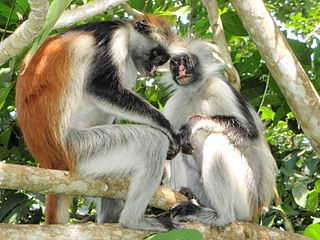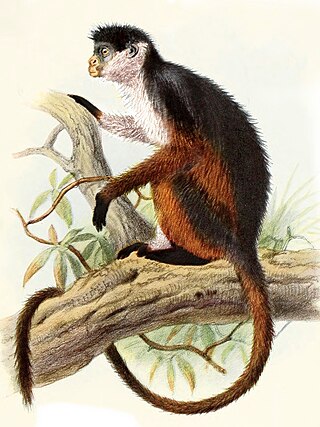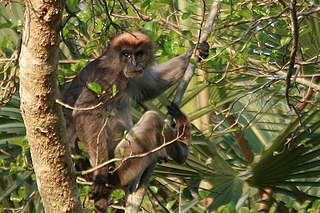
Old World monkey is the common English name for a family of primates known taxonomically as the Cercopithecidae. Twenty-four genera and 138 species are recognized, making it the largest primate family. Old World monkey genera include baboons, red colobus and macaques. Common names for other Old World monkeys include the talapoin, guenon, colobus, douc, vervet, gelada, mangabey, langur, mandrill, surili (Presbytis), patas, and proboscis monkey. Phylogenetically, they are more closely related to apes than to New World monkeys. They diverged from a common ancestor of New World monkeys around 45 to 55 million years ago.

The Zanzibar red colobus is a species of red colobus monkey endemic to Unguja, the main island of the Zanzibar Archipelago, off the coast of Tanzania. It is also known as Kirk's red colobus after Sir John Kirk, the British Resident of Zanzibar who first brought it to the attention of zoological science. It is now classified as an endangered species and in the mid-1990s was adopted as the flagship species for conservation in Zanzibar. The population is still decreasing, and conservationists are attempting to work with the local government to devise a proper, effective strategy to protect the population and habitat. Challenges include the species' habitat, which is limited to the archipelago. The species has been reclassified three times; it was previously in the genus Colobus, then in the genus Procolobus, and later in the genus Piliocolobus.

Tarsiiformes are a group of primates that once ranged across Europe, northern Africa, Asia, and North America, but whose extant species are all found in the islands of Southeast Asia. Tarsiers are the only living members of the infraorder; other members of Tarsiidae include the extinct Tarsius eocaenus from the Eocene, and Tarsius thailandicus from the Miocene. Two extinct genera, Xanthorhysis and Afrotarsius, are considered to be close relatives of the living tarsiers, and are generally classified within Tarsiiformes, with the former grouped within family Tarsiidae, and the latter listed as incertae sedis (undefined). Omomyids are generally considered to be extinct relatives, or even ancestors, of the living tarsiers, and are often classified within Tarsiiformes.
Neontology is a part of biology that, in contrast to paleontology, deals with living organisms. It is the study of extant taxa : taxa with members still alive, as opposed to (all) being extinct. For example:

The mantled guereza, also known simply as the guereza, the eastern black-and-white colobus, or the Abyssinian black-and-white colobus, is a black-and-white colobus, a type of Old World monkey. It is native to much of west central and east Africa, including Cameroon, Equatorial Guinea, Nigeria, Ethiopia, Kenya, Tanzania, Uganda and Chad. The species consists of several subspecies that differ in appearance. It has a distinctive appearance, which is alluded to in its name; the long white fringes of hair that run along each side of its black trunk are known as a mantle. Its face is framed with white hair and it has a large white tail tuft.

Red colobuses are Old World monkeys of the genus Piliocolobus. It was formerly considered a subgenus within the genus Procolobus, which is now restricted to the olive colobus. They are closely related to the black-and-white colobus monkeys, and some species are often found in groups with the blue monkey. The western red colobus is frequently hunted by the common chimpanzee.

Miss Waldron's red colobus is a species of the red colobus native to West Africa. It had previously been described as a subspecies of the western red colobus, P. badius. It has not been officially sighted since 1978 and was considered extinct in 2000. However, new evidence suggests that a very small number of these monkeys may be living in the southeast corner of Côte d'Ivoire. The IUCN Red List notes Miss Waldron's red colobus as critically endangered.

The western red colobus, also known as the bay red colobus, rust red colobus or Upper Guinea red colobus, is a species of Old World monkey in West African forests from Senegal to Ghana. All other species of red colobuses have formerly been considered subspecies of P. badius. It is often hunted by the common chimpanzee. In 1994, western red colobus monkeys infected many chimpanzees with Ebola virus when the chimpanzees hunted the monkeys as prey.

The black colobus, or satanic black colobus, is a species of Old World monkey belonging to the genus Colobus. The species is found in a small area of western central Africa. Black colobuses are large, completely covered with black fur, and like all other Colobus monkeys, do not have a thumb. The species has faced large declines in population due to habitat destruction and hunting by humans, and was consequently listed as Vulnerable on the IUCN Red List in 1994.

Pennant's colobus or Pennant's red colobus is a species of tree-dwelling primate in the family Cercopithecidae. It is endemic to tropical Central Africa. Three subspecies have traditionally been recognised but its distribution is peculiarly disjunct and has been considered a biogeographical puzzle, with one population on the island of Bioko, a second in the Niger River Delta in southern Nigeria, and a third in east-central Republic of Congo. It is found in rainforests and marshy forests. It is threatened by habitat loss and hunting for bushmeat.

The Tana River red colobus, also called the eastern red colobus, is a highly endangered species of primate in the family Cercopithecidae. It is endemic to a narrow zone of gallery forest near the Tana River in southeastern Kenya.

The olive colobus monkey, also known as the green colobus or Van Beneden's colobus, is a species of primate in the family Cercopithecidae. Its English name refers to its dull olive upperparts. It is the smallest example of all colobine monkeys and is rarely observed in its natural habitat because of its cryptic coloration and secretive nature. It is found in the rain forests of West Africa, ranging from southern Sierra Leone to Nigeria. The IUCN Red List classifies the olive colobus as vulnerable, with the cause of its decline attributed to habitat loss and hunting. Though much of the land within the range of the olive colobus has been affected by human activities, it retains its ability to thrive in small degraded forest fragments.
Stirtonia is an extinct genus of New World monkeys from the Middle Miocene. Its remains have been found at the Konzentrat-Lagerstätte of La Venta in the Honda Group of Colombia. Two species have been described, S. victoriae and the type species S. tatacoensis. Synonyms are Homunculus tatacoensis, described by Ruben Arthur Stirton in 1951 and Kondous laventicus by Setoguchi in 1985. The genus is classified in Alouattini as an ancestor to the modern howler monkeys.

The Ugandan red colobus or ashy red colobus is an endangered species of red colobus monkey, recognised as a distinct species since 2001. There is disagreement however over taxonomy with many considering the Ugandan red colobus to be a subspecies. The Ugandan red colobus is an Old World monkey which is found in five different locations across Uganda and Tanzania.

Paracolobus is an extinct genus of primate closely related to the living colobus monkeys. It lived in eastern Africa in the Pliocene and Early Pleistocene. Fossils have been found in Kenya and Ethiopia, in places such as the Omo valley.

Bouvier's red colobus is a species of colobus monkey rediscovered in the Republic of the Congo in 2015, after four decades without a confirmed sighting.
Miocallicebus is an extinct genus of New World monkeys from the Middle Miocene. Its remains have been found at the Konzentrat-Lagerstätte of La Venta in the Honda Group of Colombia. The type species is Miocallicebus villaviejai.
Patasola is an extinct genus of New World monkeys from the Middle Miocene. Its remains have been found at the Konzentrat-Lagerstätte of La Venta in the Honda Group of Colombia. The type species is Patasola magdalenae.

Foa's red colobus or the Central African red colobus, is a species of red colobus monkey found in the Democratic Republic of the Congo.
Rhinocolobus is an extinct genus of monkey closely related to modern colobus monkeys. It lived in eastern Africa during the Plio-Pleistocene, existing as recently as 1.5 million years ago.













